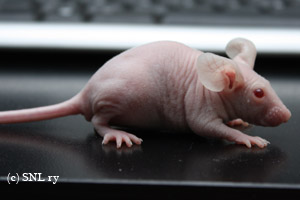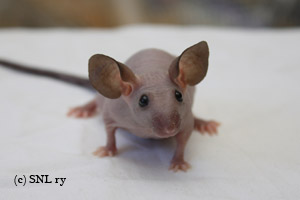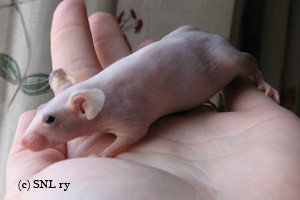Varieties
Coats
Hairless (nu)
"The hairless mouse is to be as hairless as possible. The skin to be thin, clean, partly translucent and without any cuts or bruises. The skin may be of any standardized colour and/or markings. The skin getting lighter as the mouse ages to be taken into account. Excessive wrinkling a minor fault. Eye to match colouring. Ears large and free of folds or greases. Whiskers very short or missing."
Breeding information below the pictures.

|
Nu pew doe Necropolis Emission Impossible |
 |
Darker nude from Necropolis mousery |
 |
Compare this mouse and the mouse below. Can you spot the difference? |
 |
Correct: the mouse above does not have whiskers, the mouse below does. |
Hairless (nu)
General info
Hairless mice, also called nude, have become more popular in Finland since 2010, when a new hairless gene was imported to the country. This gene was more viable and healthier compared to earlier types of hairless mice. As with other hairless animals, the extraordinary appearance of hairless mice draws attention and splits opinions.
The skin colour of hairless mice is rather light. Dark colour varieties show as grey/blue pigment and light colour varieties as pink skin colour. If a heterozygous hairless has very thin peachy coat, colours are more intense and for example pink eyed white appears whiter. The colour of hairless mice cannot be judged to the same extent as with other coat varieties, so judging focuses mainly on the quality of hairless coat as well as size and type. The most common faults with hairless mice are thin hair overall or small hair tufts here and there.
Genetics
The hairless gene found in the Finnish mouse fancy is dominant. This means that normal coated mice born from hairless mice do not pass the gene on, as it cannot be carried.
Inheritance of hairless in different combinations:
homozyg. nude x homozyg. nude = 100% homozyg. nude
homozyg. nude x heterozyg. nude = 50% homozyg. nude, 50% heterozyg. nude
homozyg. nude x normal = 100% heterozyg. nude
heterozyg. nude x normal = 50% heterozyg. nude, 50% normal
heterozyg. nude x heterozyg. nude = 50% heterozyg. nude, 25% homozyg. nude, 25% normal
The appearance of heterozygous hairless may vary a lot even in one litter: some may resemble fuzzy shorthair while some may be completely without hair. Sometimes the only way to tell apart a fuzzy and a hairless by appearance is by their whiskers; fuzzy has short curly whiskers while hairless has none. Newborn hairless are easy to recognise by their lack of whiskers, which shows clearly when examined against the light.
Homozygous nude mice are more 'leathery' hairless and have no apparent hair at any point of their development. Heterozygous nudes always have more or less hair as babies. Their baby coats consist of wavy, very soft and fluffy undercoat. As the mice grow the hair straightens and more or less disappears; some adult heterozygous hairless may be completely nude while some may retain small random tufts of hair. It is very much possible to breed perfectly hairless mice as heterozygous, without any homozygous nudes.
In more practical terms
Normal wood shavings are suitable as bedding material for hairless mice and the same types of nesting materials can be used as with other coat varieties. Some breeders abroad use thermal mats under the cages, but in well heated housing conditions this is not necessary. Snuffling or other respiratory symptoms do not seem to be any more common with hairless mice as with other coat types. Show boxes should however be well insulated with ample nesting material especially during winter and freezing conditions. Before driving to shows with hairless mice, the car should also be well heated inside.
Like other hairless animals, hairless mice may have pimples or blackheads on their skin, especially males. These will heal by themselves allowed some time and will not leave any permanent marks. However, if the mouse has pimples or blackheads it is not in good show condition.
Small cuts and nicks show all too well on hairless mice. Even after these have healed, some visible scarring may remain, which again will affect show success. Introducing hairless mice to other mice or rearranging groups should be done under close surveillance in order to avoid any accidents. Small cuts and nicks can be treated with Bepanthen ointment.
The eyes of homozygous hairless babies open noticeably earlier than with other mice. Small slits between eyelids may show even a week earlier than normal. For this reason eye problems are more common in homozygous hairless mice and the risk of cataracts is higher. In some rare cases homozygous hairless babies may be born with no eyes. All hairless mice are more prone to have some discharge from the eyes as they lack eyelashes that would normally protect the eyes, but there are also hairless mice that never have this problem.
Another issue with hairless mice is that they are more prone to have dry and scaly tails and/or heels. Dry tail is a much more common problem with hairless mice than with other coat types.
When breeding hairless mice the breeder should favor heterozygous animals and avoid homozygous ones by pairing heterozygous nudes to normal or to other heterozygous nudes. Homozygous hairless babies are totally hairless and often slightly smaller than heterozygous ones, so it is possible to cull them early. Homozygous adult hairless mice are slightly smaller as well.
The breeder of hairless mice should prioritise health aspects above all else and pay special attention to the eyes, tails and heels. In order for health problems not to become more common and uncontrollable the breeder must have a clear idea which nude mice to use for breeding and how. Breeders should also work together towards a common, healthy goal, exchanging knowledge and experiences.
